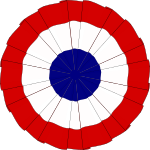民主共和党
民主共和党(英语:Democratic-Republican Party)是美国建国早期的一个政党。由美国开国元勋托马斯·杰斐逊和詹姆斯·麦迪逊在公元1792年创建。
民主共和党 Democratic-Republican Party | |
|---|---|
 民主共和党标志 | |
| 领袖 | 托马斯·杰斐逊 詹姆斯·麦迪逊 詹姆斯·门罗 安德鲁·杰克逊 |
| 成立 | 1792年 |
| 解散 | 1825年 |
| 前身 | 反行政派 |
| 继承者 | 民主党(杰克逊派) 国家共和党(反杰克逊派) |
| 意识形态 | |
| 政治立场 | 左翼[3][7] |
| 国际组织 | 无 |
| 官方色彩 | 红色、白色和蓝色 |
| 美国政治 政党 · 选举 | |
历史
编辑民主共和党的对立政党是联邦党(又叫做联邦同盟党)。与联邦党相比,民主共和党更强调各州的权力(States' rights),重视自耕农的权益,反对过分的联邦主义和君主主义。主要支持地区是中西部和南部。支持者大部分都是乡村地区的农民还有城市地区的工人,民主共和党可被视为今日美国两大党派中民主党的前身。
1792年,美国开国元勋托马斯·杰斐逊和詹姆斯·麦迪逊创建美国民主共和党。他们因为反对联邦党的领袖、时任美国财政部长的亚历山大·汉密尔顿的经济政策,退出联邦政府,成为反对党。
1796年的美国总统选举,民主共和党领袖杰斐逊输给联邦党候选人、时任美国副总统的约翰·亚当斯,但杰斐逊是该次选举得票数第二多的候选人而成为副总统,随后宪法修正案区分总统和副总统候选人,使总统的对手不会因得票数第二而成为副总统。
1800年的美国总统选举,杰斐逊在国会选举人票中,击败寻求连任的亚当斯,终于当选总统,并于1804年通过美国宪法第十二修正案,获得连任。之后,民主共和党人麦迪逊和詹姆斯·门罗赢得之后的四次美国总统选举,使得民主共和党连续执政长达24年,使其主要竞争对手联邦党逐渐式微并融入民主共和党。
1824年的美国总统选举,由于民主共和党未能协调出单一候选人,四名民主共和党人同时参选,最终普选票和选举人票为四人中最多的安德鲁·杰克逊在众议院选举中未能获国会众议员的支持而落选,而是由亨利·克莱支持的约翰·昆西·亚当斯当选总统,而克莱则获亚当斯任命为国务卿,此次选举结果导致以民主共和党和联邦党为背景的两大派系就此溶解,转为亲杰克逊派(Jacksonian)和反杰克逊派(Anti-Jacksonian)的竞争。
1828年和1832年的美国总统选举,分别由亚当斯、克莱与杰克逊对垒;亚当斯和克莱的支持阵营被称为国家共和党(其后又成立辉格党),而杰克逊的支持阵营则组成民主党(Democratic Party)。
参见
编辑注释
编辑- ^ Ohio History Connection. Democratic-Republican Party. Ohio History Central. [2017-08-30]. (原始内容存档于2021-12-29).
Democratic-Republicans favored keeping the U.S. economy based on agriculture and said that the U.S. should serve as the agricultural provider for the rest of the world […]. Economically, the Democratic-Republicans wanted to remain a predominantly agricultural nation, [...].
- ^ Beasley, James R. Emerging Republicanism and the Standing Order: The Appropriation Act Controversy in Connecticut, 1793 to 1795. The William and Mary Quarterly. 1972, 29 (4): 604. JSTOR 1917394. doi:10.2307/1917394.
- ^ 3.0 3.1 Larson, Edward J. A Magnificent Catastrophe: The Tumultuous Election of 1800, America's First Presidential Campaign. 2007: 21. ISBN 9780743293174.
The divisions between Adams and Jefferson were exasperated by the more extreme views expressed by some of their partisans, particularly the High Federalists led by Hamilton on what was becoming known as the political right, and the democratic wing of the Republican Party on the left, associated with New York Governor George Clinton and Pennsylvania legislator Albert Gallatin, among others.
- ^ Adams, Ian. Political Ideology Today reprinted, revised. Manchester: Manchester University Press. 2001: 32 [2021-05-27]. ISBN 9780719060205. (原始内容存档于2021-12-16).
Ideologically, all US parties are liberal and always have been. Essentially they espouse classical liberalism, that is a form of democratized Whig constitutionalism plus the free market. The point of difference comes with the influence of social liberalism.
- ^ Wood, The American Revolution, p. 100
- ^ Democratic-Republican Party. Encyclopædia Britannica. 1998-07-20 [2017-08-30]. (原始内容存档于2018-06-15).
The Republicans contended that the Federalists harboured aristocratic attitudes and that their policies placed too much power in the central government and tended to benefit the affluent at the expense of the common man.
- ^ Ornstein, Allan. Class Counts: Education, Inequality, and the Shrinking Middle Class. Rowman & Littlefield Publishers. 9 March 2007: 56–58. ISBN 9780742573727.